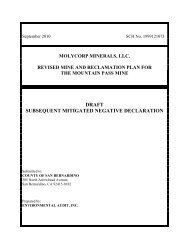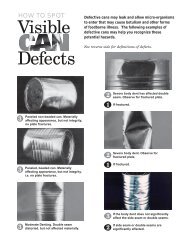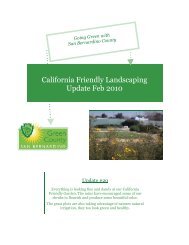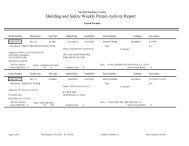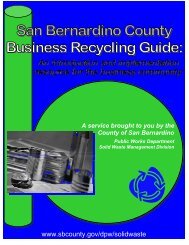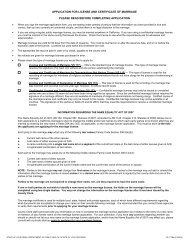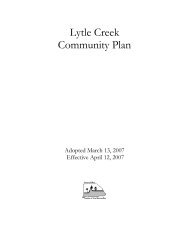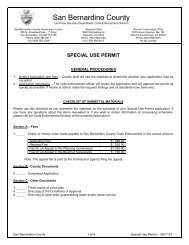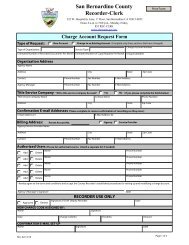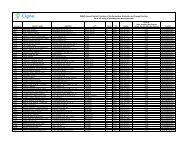Upper Cactus Basins Flood Control System Enhancement Project ...
Upper Cactus Basins Flood Control System Enhancement Project ...
Upper Cactus Basins Flood Control System Enhancement Project ...
Create successful ePaper yourself
Turn your PDF publications into a flip-book with our unique Google optimized e-Paper software.
<strong>Upper</strong> <strong>Cactus</strong> <strong>Basins</strong><strong>Flood</strong> <strong>Control</strong> <strong>System</strong><strong>Enhancement</strong> <strong>Project</strong>Final SupplementalEnvironmental Impact ReportSCH No. 1987110914Prepared by:Lilburn CorporationSan Bernardino, CaliforniaLead Agency:San Bernardino County <strong>Flood</strong> <strong>Control</strong> DistrictSan Bernardino, CaliforniaMarch 2013
TABLE OF CONTENTSPage1.0 INTRODUCTION .............................................................................................................. 1-11.1 PURPOSE .................................................................................................................. 1-11.2 FINAL EIR REQUIREMENTS ................................................................................ 1-11.3 USE OF THE EIR IN THE DECISION-MAKING PROCESS ................................ 1-11.4 SIGNIFICANT AND UNAVOIDABLE IMPACTS ................................................ 1-22.0 CEQA PUBLIC REVIEW PROCESS................................................................................ 2-12.1 PURPOSE OF PUBLIC REVIEW ............................................................................ 2-12.2 PUBLIC REVIEW PERIOD AND NOTIFICATIONS ............................................ 2-12.3 SUMMARY OF PUBLIC INPUT ............................................................................. 2-23.0 DRAFT EIR ERRATA ....................................................................................................... 3-13.1 OVERVIEW .............................................................................................................. 3-13.2 ERRATA.................................................................................................................... 3-23.2.1 Errata to Draft SEIR Section 3.1 Background ............................................... 3-23.2.2 Errata to Draft SEIR Section 3.4 Site Characteristics .................................... 3-33.2.3 Errata to Draft SEIR Section 3.5.2 Major Components of Proposed <strong>Project</strong> .3.33.2.4 Errata to Draft SEIR Section 4.2.3 Impacts and Mitigation Measures .......... 3-53.2.5 Errata to Draft SEIR Section 4.2.3 Impacts and Mitigation Measures .......... 3-53.2.6 Errata to Draft SEIR Section 4.2.3 Impacts and Mitigation Measures .......... 3-63.2.4 Errata to Draft SEIR Appendix D Jurisdictional DelineationSeptember 2012 ............................................................................................. 3-64.0 COMMENTS AND RESPONSES ..................................................................................... 4-15.0 MITIGATION MONITORING AND REPORTING PROGRAM .................................... 5-15.1 INTRODUCTION ..................................................................................................... 5-15.2 RESPONSIBILITIES AND AUTHORITY .............................................................. 5-15.3 MONITORING PERSONNEL .................................................................................. 5-1LIST OF FIGURES3-3 Existing Conditions .......................................................................................................... 3-43-4 <strong>Project</strong> Plans..................................................................................................................... 3-76 CDFG Jurisdiction and Impacts ....................................................................................... 3-8LIST OF TABLES4-1 Comment Letters Received on the Draft Environmental Impact Report ......................... 4-15-1 Mitigation Monitoring and Reporting Program ............................................................... 5-3<strong>Upper</strong> <strong>Cactus</strong> <strong>Basins</strong> <strong>Enhancement</strong> <strong>Project</strong>iMarch 2013Final Supplemental EIR
1.0 Introductionby the Final SEIR) reviews the environmental consequences of the <strong>Project</strong>, as described inChapter 4 of the Draft SEIR..Responsible agencies will use the EIR to decide whether to approve the discretionaryentitlements being requested. The District has made this Final EIR available prior to hearings on<strong>Project</strong> approval or denial to provide an opportunity for agency and public review of thecomplete EIR before decisions are made. In addition, the District provided each of thecommenting agencies a CD copy of this Final EIR at least 10 days before the public hearing forcertification of the Final EIR.Upon review of the Final SEIR, and before rendering decisions on the discretionary actions, theSan Bernardino County Board of Supervisors, acting as the Board of the <strong>Flood</strong> <strong>Control</strong> District,must certify that:The Final SEIR has been completed in compliance with CEQA,The Final SEIR was presented to the decision-making body of the Lead Agency, andThe information was reviewed and considered before approving the project.1.4 SIGNIFICANT AND UNAVOIDABLE IMPACTSThe analysis determined that no significant environmental impacts would remain significant aftermitigation for any of the issues analyzed in Chapter 4 of the Draft EIR. Therefore, a statement ofoverriding considerations is not required for the Proposed <strong>Project</strong>.<strong>Upper</strong> <strong>Cactus</strong> <strong>Basins</strong> <strong>Enhancement</strong> <strong>Project</strong>March 2013 1-2 Final Supplemental EIR
2.0 CEQA Public Review Process2.0 CEQA PUBLIC REVIEW PROCESS2.1 PURPOSE OF PUBLIC REVIEWCEQA Guidelines Section 15201 states:“Public participation is an essential part of the CEQA process. Each publicagency should include provisions in its CEQA procedures for wide publicinvolvement, formal and informal, consistent with its existing activities andprocedures, in order to receive and evaluate public reactions to environmentalissues related to the agency’s activities. Such procedures should include,whenever possible, making environmental information available in electronicformat on the Internet, on a web site maintained or utilized by the public agency.”The San Bernardino County <strong>Flood</strong> <strong>Control</strong> District (District) has invited public input during theEIR preparation process, including providing opportunities to review and comment during theNotice of Preparation circulation period and during a 60-day public review period for the DraftSEIR, as discussed further in Section 2.2.CEQA (California Public Resources Code (PRC) § 21082.2(b)) explains that, “Statements in anenvironmental impact report and comments concerning an environmental impact report shall notbe determinative of whether the project may have a significant effect on the environment.”According to CEQA, it is the responsibility of the lead agency decision makers to “determinewhether a project may have a significant effect on the environment based on substantial evidencein the record.” Substantial evidence is defined as facts, fact-related reasonable assumptions, andexpert opinion. “Substantial evidence” does not include arguments, speculation, unsubstantiatedopinion or narrative, clearly erroneous evidence, or socioeconomic impacts not related to thephysical environment (PRC § 21080(e), 21082.2(a), 21082.2(c), and CEQA Guidelines§ 15384).2.2 PUBLIC REVIEW PERIOD AND NOTIFICATIONSIn accordance with both the specific requirements and the intent of CEQA, the environmentalreview process for the <strong>Project</strong> has included substantial opportunities for public and agencyreview and comment on the environmental evaluations. The public review process for the <strong>Project</strong>EIR has included the following opportunities:A Notice of Preparation (NOP) was prepared for the <strong>Project</strong> and circulated to allresponsible agencies and interested parties beginning on September 20, 2012, for a periodof 30 days.A Notice of Completion for the Draft SEIR was filed with the Office of Planning andResearch, State Clearinghouse on November 30, 2012, and a Notice of Availability wasposted on the District’s website and mailed to property owners within a 600-foot radiusof the <strong>Project</strong> Site. The public review period was established as 60 days. The Draft SEIR was circulated for review and comment between November 30, 2012,and January 29, 2013.<strong>Upper</strong> <strong>Cactus</strong> <strong>Basins</strong> <strong>Enhancement</strong> <strong>Project</strong>Final Supplemental EIR 2-1 March 2013
3.0 Draft EIR Erratachanges in the <strong>Project</strong> Description not addressed in the 2008 SEIR as well as changes to theregulatory environment that have occurred since 2008, and the finding of least Bell’s vireo, afederal and State Endangered species at the <strong>Project</strong> Site.END OF ERRATA3.2.2 Errata to Draft SEIR Section 3.4 Site Characteristics (page 3-5)ExplanationThe following text revision adds a figure reference to the third paragraph of Section 3.4 SiteCharacteristics (page 3-5) of the Draft SEIR and incorporates a new figure. The figure,Figure 3-3 Existing Conditions, is added to the document at the request of the CaliforniaDepartment of Fish and Wildlife as stated in Comment 4-15 of their January 24, 2013 commentletter. This errata does not add significant new information to the EIR and does not requirerecirculation of the Draft SEIR (see CEQA Guidelines § 15088.5).ERRATAUnder existing conditions, Basin 3/3A is in-line with <strong>Cactus</strong> Channel to the north and RialtoChannel to the south; <strong>Basins</strong> 4 and 5 are off-line and do not receive or transfer stormwater flows.All flows entering the existing system come from a concrete box structure under Easton Streetand into <strong>Cactus</strong> Channel. <strong>Cactus</strong> Channel is a deeply incised conduit immediately east of <strong>Basins</strong>5 & 4. Flows from the Channel outlet into Basin 3/3A, then they are transferred to the RialtoChannel (see Figure 3-3).END OF ERRATA3.2.3 Errata to Draft SEIR Section 3.5.2 Major Components of Proposed <strong>Project</strong>(page 3-7)ExplanationThe following text revision renumbers the figure reference in the second paragraph of page 3-7of Section 3.5.2 Major Components of Proposed <strong>Project</strong> from Figure 3-3 to Figure 3-4.Renumbering of the figure is required following the addition of the Existing Conditions figure asdiscussed in Section 3.2.2 above. Additionally, the figure has been updated to include equipmentstaging and stockpiling locations within the project area. This errata does not add significant newinformation to the SEIR and does not require recirculation of the Draft SEIR (see CEQAGuidelines § 15088.5).ERRATAThe proposed project would widen and deepen <strong>Cactus</strong> <strong>Basins</strong> 3/3A, 4, and 5. The three basinswould be excavated to a uniform depth of approximately 1,346 feet asl. In order to align thebasins in the subject property the basins would be widened to the east to the location of the<strong>Upper</strong> <strong>Cactus</strong> <strong>Basins</strong> <strong>Enhancement</strong> <strong>Project</strong>Final Supplemental EIR 3-3 March 2013
<strong>Project</strong> Boundary0 400Approximate FeetLILBURNC O R P O R A T I O NExisting Conditions<strong>Upper</strong> <strong>Cactus</strong> <strong>Basins</strong> <strong>Enhancement</strong> <strong>Project</strong>City of Rialto, San Bernardino County, CaliforniaFigure 3-3
3.0 Draft EIR Errata3.2.6 Errata to Draft SEIR Section 4.2.3 Impacts and Mitigation Measures (page 4.2-13)ExplanationThe following text revision updates proposed Mitigation Measure BIO-3. The language usesdata compiled subsequent to the preparation of the Draft SEIR for preparation of the DraftHabitat Monitoring and Mitigation Program to quantify the proposed compensatory riparianmitigation area and clarify the objective of the mitigation measure. This errata does not addsignificant new information to the SEIR and does not require recirculation of the Draft SEIR (seeCEQA Guidelines § 15088.5).Mitigation Measure BIO-3ERRATAImpacts for the loss of 8.8 acres of riparian habitat shall be compensated at a two to oneratio via the restoration and enhancement of 14.6 acres (11.8 acres of which are Waters ofthe U.S.) of willow riparian habitat in an earthen channel portion of the Rialto Channel. Thiscompensation also covers the loss of Least Bell’s vireo habitat in the basins.3.2.7 Errata to Draft SEIR Appendix D Jurisdictional Delineation September 2012(page 15)ExplanationThe following text revision is to correct a reported acreage impact on Figure 6 CDFGJurisdiction and Impacts of the Jurisdictional Delineation included as Appendix D of the DraftSEIR. The legend incorrectly identifies impacts to Chaparral vegetation at 3.7 acres, the correctimpact is identified in the text of Section 6.4.1 and Table 1 of the Jurisdictional Delineation. Thecorrect impact should be 0.1 acres, the 3.7 acres reported in the figure refers the total area ofchaparral vegetation in the project area and not the amount of vegetation that will be impacted inthe area under the jurisdiction of the California Department of Fish and Wildlife. This errata doesnot add significant new information to the SEIR and does not require recirculation of the DraftSEIR (see CEQA Guidelines § 15088.5).ERRATAA revised Figure 6 of the JD included in the Draft SEIR as Appendix D, showing the correctedlegend follows.<strong>Upper</strong> <strong>Cactus</strong> <strong>Basins</strong> <strong>Enhancement</strong> <strong>Project</strong>March 2013 3-6 Final Supplemental EIR
Staging Area/Stockpile AreaStaging Area/Stockpile AreaStaging Area/Stockpile Area0 400Approximate FeetLILBURNC O R P O R A T I O N<strong>Project</strong> Plans<strong>Upper</strong> <strong>Cactus</strong> <strong>Basins</strong> <strong>Enhancement</strong> <strong>Project</strong>City of Rialto, San Bernardino County, CaliforniaFigure 3-4 Figure 3-3
Temporary ImpactsLEGENDStreambedPermanent ImpactsRiversidean Sage ScrubDisturbed HabitatStreambed10.6 acres6.1 acres0.5 acres15.0 acresWillow Cottonwood Woodland 7.6 acresChaparral 0.1 3.7 acresMulefat ScrubTotal Acreage: 41.11.2 acresCDFG Jurisdiction and Impacts<strong>Upper</strong> <strong>Cactus</strong> <strong>Basins</strong> <strong>Enhancement</strong> <strong>Project</strong>City of Rialto, San Bernardino County, CaliforniaFigure 60 600Approximate FeetLILBURNC O R P O R A T I O N
4.0 Comments and Responses4.0 COMMENTS AND RESPONSESThis chapter of the Final SEIR provides specific responses to each issue raised in comments onthe Draft SEIR.The public comment period for the Draft SEIR began November 30, 2012 and ended January 29,2013. A total of five comment letters were received. These are listed in Table 4-1 and areidentified by a number. Individual comments within each letter are identified with a uniquenumeric indicator. For example the comment letter from the California Department of Fish andWildlife is Letter 4. The letter contains twenty-seven comments identified as comments 4-1through 4-27. All comment letters are provided in their original form in Appendix A, CommentLetters Received on the Draft EIR.Table 4-1Comment Letters Received on the Draft Environmental Impact ReportLetter Name Date on Letter1State of California, Governor’s Office ofPlanning and Research, State Clearinghouse UnitJanuary 25, 20132State of California, Governor’s Office ofPlanning and Research, State Clearinghouse UnitJanuary 25, 20133State of California, Department ofTransportationDecember 11, 20124State of California, Department of Fish andWildlifeJanuary 24, 20135 San Bernardino Valley Municipal Water District January 30, 2013<strong>Upper</strong> <strong>Cactus</strong> <strong>Basins</strong> <strong>Enhancement</strong> <strong>Project</strong>Final Supplemental EIR 4-1 March 2013
4.0 Comments and ResponsesLetter No. 1State of California Governor’s Office of Planning and Research: State Clearinghouse andPlanning Unit, January 25, 2013Comment 1-1:Response 1-1:Comment noted; no response necessary.Comment 1-2:Response 1-2:Comment noted; no response necessary.Comment 1-3:Response 1-3:Comment noted; no response necessary.Comment 1-4:Response 1-4:Comment noted; no response necessary.<strong>Upper</strong> <strong>Cactus</strong> <strong>Basins</strong> <strong>Enhancement</strong> <strong>Project</strong>March 2013 4-2 Final Supplemental EIR
4.0 Comments and ResponsesLetter No. 2State of California Governor’s Office of Planning and Research State Clearinghouse andPlanning Unit, January 25, 2013Comment 2-1:Response 2-1:Comment noted; no response necessary.Comment 2-2:Response 2-2:Comment noted; no response necessary.<strong>Upper</strong> <strong>Cactus</strong> <strong>Basins</strong> <strong>Enhancement</strong> <strong>Project</strong>Final Supplemental EIR 4-3 March 2013
4.0 Comments and ResponsesLetter No. 3Department of Transportation District 8, December 11, 2012Comment 3-1:Response 3-1:This is an introductory comment that does not address the adequacy of the Draft SEIR. Nofurther response is warranted.Comment 3-2:Response 3-2:The District concurs that the project does not impact the SHS and that Caltrans reserves the rightto comment on any future revisions to this project.Comment 3-3:Response 3-3:Comment noted; Caltrans will be notified should the project be modified.<strong>Upper</strong> <strong>Cactus</strong> <strong>Basins</strong> <strong>Enhancement</strong> <strong>Project</strong>March 2013 4-4 Final Supplemental EIR
4.0 Comments and ResponsesLetter No. 4California Department of Fish and Wildlife Inland Deserts Region, January 24, 2013Comment 4-1:<strong>Upper</strong> <strong>Cactus</strong> <strong>Basins</strong> <strong>Enhancement</strong> <strong>Project</strong>Final Supplemental EIR 4-5 March 2013
4.0 Comments and ResponsesResponse 4-1:Most of this comment is an introductory comment that does not address the adequacy of theDraft EIR and no further response is warranted. However, the Department indicates that thespecifics of the Maintenance Plan are not addressed. The Maintenance Plan activities areincluded as part of the <strong>Project</strong> Description and described on DEIR page 3-9 at the level of detailsufficient for planning and permitting purposes. Actual quantities of vegetation removal andsediment removal cannot be quantified at this time as both would be dependent upon futureannual hydrological conditions. The District indicated the amount of sediment that will beremoved during project construction (see Table 3-1 on DEIR Page 3-7); this would be the“baseline” amount and no annual maintenance would be expected to exceed this quantity.Vegetation removal is anticipated to be limited to basin bottoms, but again will be dependentupon future annual conditions.Comment 4-2:Response 4-2:The District considered that although the site will not be utilized at this time for groundwaterrecharge, it could potentially have an impact on the plume due to percolation of storm flows andtherefore, the District reviewed available literature posted by the U.S. Environmental ProtectionAgency. Additionally, the District is aware of other on-going investigations of the plume of<strong>Upper</strong> <strong>Cactus</strong> <strong>Basins</strong> <strong>Enhancement</strong> <strong>Project</strong>March 2013 4-6 Final Supplemental EIR
4.0 Comments and ResponsesResponse 4-3:This comment accurately summarizes Section 4-2 Biological Resources of the DraftSupplemental EIR. No further response is necessary.<strong>Upper</strong> <strong>Cactus</strong> <strong>Basins</strong> <strong>Enhancement</strong> <strong>Project</strong>March 2013 4-8 Final Supplemental EIR
4.0 Comments and ResponsesComment 4-4:Response 4-4:This is an introductory comment that summarizes the findings of the Jurisdictional Delineationcompleted in 2012. No further response is necessary.Comment 4-5:Response 4-5:The comment addresses a Lake or Streambed Alteration Agreement issued by the Department in1987 for Lake and Streambed Alteration Agreement LSAA 6-2002-193 (LSAA). The commentindicates that mitigation agreed to in the 1987 EIR has not been implemented. The Draft EIR forthe current Proposed <strong>Project</strong> lists mitigation measures as shown below. These MitigationMeasures were determined to reduce the potential impacts of the Proposed <strong>Project</strong> to less thansignificant while providing substantially more mitigation than legally required.Mitigation Measure BIO-1Pursuant to the 1988 EIR, the loss of alluvial fan sage scrub shall be mitigated off-site bypreserving approximately 45 acres of alluvial fan sage scrub reserve. The potential locationsidentified in the 1988 EIR were Lytle Creek, San Sevaine Creek and Cucamonga Creek. TheSan Bernardino County <strong>Flood</strong> <strong>Control</strong> District (SBCFCD) has agreed to preserve 45 acres<strong>Upper</strong> <strong>Cactus</strong> <strong>Basins</strong> <strong>Enhancement</strong> <strong>Project</strong>Final Supplemental EIR 4-9 March 2013
4.0 Comments and ResponsesAs a result of the U.S. Army Corps of Engineers’ review of the draft EA for their issuance of a404 Permit, a Habitat Mitigation and Monitoring Plan (HMMP) is being prepared for themitigation land in the Rialto Channel. A graphic representation of the proposed mitigation area,showing vegetation type that will be included in the HMMP boundaries is provided below topresent additional information gathered since circulation of the Draft EIR.Comment 4-6:Response 4-6:The District understands that the CEQA process must be completed and that an NOD must beobtained as a requirement for the execution of a Lake or Streambed Alteration Agreement for<strong>Project</strong> impacts to 41.1 acres of State jurisdictional waters. The District has identified locations<strong>Upper</strong> <strong>Cactus</strong> <strong>Basins</strong> <strong>Enhancement</strong> <strong>Project</strong>Final Supplemental EIR 4-11 March 2013
4.0 Comments and Responsesfor on-site mitigation, off-site compensatory mitigation, as well as future monitoring, fundingsources, and habitat management plan and reporting commitments; the map to be included in theHabitat Management and Monitoring Plan is being included in the Final EIR. Section 4-2 of theDraft Supplemental EIR has been updated to include this information.The Proposed <strong>Project</strong> will not be growth-inducing, but will accommodate existing and plannedgrowth by providing protection and safety for the public and property as a result of a 100-yearflood event. The project evaluated in 1988 was consistent with the City of Rialto General Plan(see pages 5-5 and 5-6 of September 1988 Final EIR – <strong>Upper</strong> <strong>Cactus</strong> Basin <strong>Flood</strong> <strong>Control</strong>Facility). Although the City updated its General Plan in 2010, development in the area has notmeasurably changed since the 1988 EIR was prepared and therefore additional analysis was notprovided, nor necessary, in the Supplemental Draft EIR.Comment 4-7:Response 4-7:The District evaluated potential project alternatives that included avoidance of the stream andriparian habitat in Section 4.2 of the Draft Supplemental EIR. The District determined that thesealternatives did not meet the overall <strong>Project</strong> purpose. The District is aware of the mitigationrequirements as well as potential additional mitigation requirements through the CaliforniaDepartment of Fish and Wildlife (CDFW) Streambed Alteration Agreement process. The Districthas updated Section 4.2 of the Draft Supplemental EIR to address on-site mitigation and off-sitecompensatory mitigation (refer to Response to Comment 4-1).Comment 4-8:Response 4-8:The comment has been noted. The District will submit a Notification of Lake or StreambedAlteration to the CDFW.<strong>Upper</strong> <strong>Cactus</strong> <strong>Basins</strong> <strong>Enhancement</strong> <strong>Project</strong>March 2013 4-12 Final Supplemental EIR
4.0 Comments and ResponsesComment 4-9:Response 4-9:The comment has been noted. The above listed information will be included in the applicationfor a Lake and Streambed Alteration Agreement.Comment 4-10:Response 4-10:The Comment has been noted. Please refer to Draft EIR page 4.2-13 and Response to Comment4-6 above.Comment 4-11:Response 4-11:This is an introductory comment to the comments 4-12 to 4-27 addressed below.<strong>Upper</strong> <strong>Cactus</strong> <strong>Basins</strong> <strong>Enhancement</strong> <strong>Project</strong>Final Supplemental EIR 4-13 March 2013
4.0 Comments and ResponsesComments 4-12 to 4-27:Response 4-12:The sand and gravel extraction activities were approved as part of the 1987 project descriptionand impacts associated with these basin construction activities were evaluated in the CEQAdocument at that time. Sand and gravel extraction is not part of the current Proposed <strong>Project</strong>.Response 4-13:An Environmental Assessment and 404 Permit Application/Notification have been prepared forthe U.S. Army Corps of Engineers to issue a 404 Permit. That permit, for the Proposed Action, isexpected to be issued in March 2013.Response 4-14:Please see response to Comment 4-5 above.<strong>Upper</strong> <strong>Cactus</strong> <strong>Basins</strong> <strong>Enhancement</strong> <strong>Project</strong>March 2013 4-14 Final Supplemental EIR
4.0 Comments and ResponsesResponse 4-15:An aerial graphic of the project area prior to the implementation of the <strong>Project</strong> and without theproject Plan has been incorporated into the EIR; please see Errata Section of this FEIR. Thefigure has been annotated to identify the location of the Habitat Restoration Area, the <strong>Basins</strong>, andthe Rialto and <strong>Cactus</strong> Channels. Conditions following implementation of the project are depictedin Figure 3-4 of the Draft Supplemental EIR.Response 4-16:Permanent and temporary impacts in the 116-acre project area are identified in Figure 6 of theBiological Resources Assessment included as Appendix C of the Draft Supplemental EIR.Permannent and temporary impacts within the jurisdiction of the CDFW are identified in Figure6 of the Jurisdictional Delineation included as Appendix D of the Draft Supplemental EIR.Response 4-17:The District has identified the need to construct improvements to the <strong>Upper</strong> <strong>Cactus</strong> <strong>Basins</strong> inorder to alleviate stress on the portion of the flood control system downstream of the <strong>Project</strong> Site(<strong>Cactus</strong> <strong>Basins</strong> 1 and 2). The overall project objective is to provide 100-year flood protection toresidences, businesses, and public infrastructure adjacent to <strong>Cactus</strong> Channel and Rialto Channelin the Cities of Rialto and Colton, and unincorporated San Bernardino County, California.Increased runoff from the construction of Interstate 210, to the north of the basins (completed in2007), and continued development of new residential, commercial, and industrial uses upstream,have and will continue to increase demands on the flood control system and the subject basins.Completion of the <strong>Upper</strong> <strong>Cactus</strong> <strong>Basins</strong> <strong>Enhancement</strong> <strong>Project</strong> would effectively stagger peakflows to reduce potential downstream flood hazard impacts associated with existing andprojected development in northen Rialto. The proposed project is not growth inducing; it isnecessitated by existing development as well development that is planned for the future (refer toResponse to Comment 4-6 and Draft EIR Section 3.5.1).Response 4-18:The District has conducted trapping surveys for San Bernardino Kangaroo Rat (SBKR) at the<strong>Upper</strong> <strong>Cactus</strong> <strong>Basins</strong> on three occasions in 2012, 2006, and 2001. One adult male SBKR wastrapped in 2012, one male was trapped in 2006, and negative results were obtained in 2001.Based on the trapping survey results the District has determined that portions of the propertysupport SBKR habitat. Approximately 16 acres of the 116 acre property have been identified aslow quality SBKR habitat based on the presence of suitable vegetation or loose sandy soils. Theremainder of the property is considered extremely low quality habitat due to the absence ofsuitable vegetation and hard packed soils. The ACOE will be consulting with U.S. Fish andWildlife for mitigating impacts to the species; the County intends compensation to be providedwithin the 45 acres of RAFSC which includes the identified SBKR habitat.<strong>Upper</strong> <strong>Cactus</strong> <strong>Basins</strong> <strong>Enhancement</strong> <strong>Project</strong>Final Supplemental EIR 4-15 March 2013
4.0 Comments and ResponsesResponse 4-19:Under existing conditions, Basin 3/3A is in-line with <strong>Cactus</strong> Channel to the north and RialtoChannel to the south; <strong>Basins</strong> 4 and 5 are off-line and do not receive or transfer stormwater flows.Existing vegetation in Basin 5 is described as Riversidean sage scrub on the slopes and disturbedhabtat at the basin bottom and access roads. Please refer to the updated Section 4-2 forinformation regarding proposed mitigation for impacts to vegetation.In September 2012, Lilburn Corporation prepared a Jurisdictional Delineation for the <strong>Upper</strong><strong>Cactus</strong> <strong>Basins</strong> <strong>Enhancement</strong> <strong>Project</strong> that updated the 2006, Scott White Biological Consutlingreport titled Jurisdictional Wetlands, Streambeds, andWaters of the United States: <strong>Cactus</strong> BasinNo. 3 and 3A. The 2012 field survey and data collection for the updated jurisdictonal delineationof <strong>Basins</strong> 3/#A, 4, 5 and the <strong>Cactus</strong> Channel resulted in the conclusion that no wetlands occur atthe project site. The “no wetland” determination is different than what was concluded in 2006. Inorder to resolve the conflicting conclusions, soil pits were sampled to determine the presence ofhydric soils. No hydric soils were identified to occur at the site. The Jurisdictional Determinationconcluded that <strong>Basins</strong> 4 and 5 are not wetlands adjacent to or part of Waters of the United States.Therefore, the Proposed <strong>Project</strong> will not have an impact on wetlands in Basin 5.Response 4-20:Please refer to Responses to Comments 4-5 and 4-6.Response 4-21:Please see response to Comment 4-6.Response 4-22:No comment letter was received or is necessary from the United States Environmental ProtectionAgency as recharge operations that would directly or indirectly affect the underlying plume arenot a part of the Proposed <strong>Project</strong>. Please see Response to Comment 4-2 above.Response 4-23:Please see Response to Comment 4-3 above.Response 4-24:Please see response to Comment 4-8 above.Response 4-25:Figure 3-3 of the Draft SEIR has been revised (now Figure 3-4) to identify the project stagingand stockpiling areas.<strong>Upper</strong> <strong>Cactus</strong> <strong>Basins</strong> <strong>Enhancement</strong> <strong>Project</strong>March 2013 4-16 Final Supplemental EIR
4.0 Comments and ResponsesResponse 4-26:Per the proposed design, the areas of the basin bottoms will be as follows:Basin 3/3A:Basin 4:Basin 5:14.45 ac.12.96 ac.6.92 ac.Response 4-27:The District has submitted an application for a Department of the Army Individual Permit fromthe Army Corps of Engineers (ACOE). The ACOE will be intiating formal consultation forimpacts to SBKR and LBV.<strong>Upper</strong> <strong>Cactus</strong> <strong>Basins</strong> <strong>Enhancement</strong> <strong>Project</strong>Final Supplemental EIR 4-17 March 2013
4.0 Comments and ResponsesLetter No. 5San Bernardino Valley Municipal Water District, January 30, 2013Comment 5-1:Response 5-1:Intordocutury comment. No further response is necessary.Comment 5-2:Response 5-3:The District has reviewed the text in question and finds that the text included an error: Thefollowing edits will be incorporated into the Final EIR:A portion of the infrastructure necessary for future recharge will be installed in thewesterly easterly basins’ embankments as part of infilling the existing <strong>Cactus</strong> Channel.adjacent to <strong>Basins</strong> 4 and 5.Note that the <strong>Cactus</strong> Channel outlets to <strong>Basins</strong> 3/3A.<strong>Upper</strong> <strong>Cactus</strong> <strong>Basins</strong> <strong>Enhancement</strong> <strong>Project</strong>March 2013 4-18 Final Supplemental EIR
4.0 Comments and ResponsesComment 5-3:Response 5-3:The District disagrees with the assertion that the sole reason that the basin enhancements asdefined in the Proposed <strong>Project</strong> will not allow for groundwater recharge is the State WaterResources <strong>Control</strong> Board Decision 1649. The limit on the use of the <strong>Cactus</strong> <strong>Basins</strong> for rechargepurposes is directly related to the existing groundwater contamination in the Rialto-Colton Basin.Decision 1649 responded to the request of San Bernardino Valley Municipal Water District(SBVMWD) to appropriate water from the Santa Ana River and the proposed use of theDistrict’s <strong>Cactus</strong> <strong>Basins</strong> for possible recharge activities. The 2004 Santa Ana River Water RightApplications for Supplemental Water Supply Draft EIR states on page 3.2-1 that the amount ofwater proposed to be recharged by the SBVMWD in <strong>Cactus</strong> <strong>Basins</strong> on a monthly basis, based ona spreading area of approximately 46 acres and an estimated percolation rate of 1.5 ft/day wouldbe 2,070 acre-feet. This is substantially more water than the District currently calculates will becaptured and detained in the basins during a 100-year storm event. See Response toComment 4-2, above.The District cites the following from the referenced Decision 1649: “Inferences can be maderegarding the possible interactions between project recharge activities and contaminant plumesand contaminant concentration levels in the Rialto-Colton groundwater basin. However,quantifying the magnitude of contaminant plume spreading requires the use of spatiallydistributedphysically-based numerical groundwater flow model (Muni/Western 4-4, p. 2-57).Therefore, potential impacts from project recharge water on the Rialto-Colton groundwatercontaminant plume have not been adequately evaluated. Accordingly, this order does not permitMuni/Western to operate the <strong>Cactus</strong> Spreading and <strong>Flood</strong> <strong>Control</strong> <strong>Basins</strong>.” The District defers tothe determination of the State Water Resources <strong>Control</strong> Board that would not authorize the useof the <strong>Cactus</strong> <strong>Basins</strong> for recharge due to an inadequate evaluation of the existing contaminantplume; clearly the source of the recharge water is immaterial to the evaluation of the impactsfrom recharged water on that existing groundwater contamination. Thus, the District hasdetermined that the current basin enhancement project does not consider or seek approval of theuse of the <strong>Cactus</strong> <strong>Basins</strong> for the type of recharge described in SWRCB Decision 1649.<strong>Upper</strong> <strong>Cactus</strong> <strong>Basins</strong> <strong>Enhancement</strong> <strong>Project</strong>Final Supplemental EIR 4-19 March 2013
5.0 Mitigation Monitoring and Reporting Program5.0 MITIGATION MONITORING AND REPORTING PROGRAM5.1 INTRODUCTIONThe mitigation monitoring and reporting program (MMRP), shown as Table 9-1 at the end of thissection, was prepared to implement the mitigation measures identified for the <strong>Upper</strong> <strong>Cactus</strong><strong>Basins</strong> <strong>Flood</strong> <strong>Control</strong> <strong>System</strong> <strong>Enhancement</strong> <strong>Project</strong>. CEQA Section 21081.6 requires adoption ofa monitoring program when mitigation measures have been identified that would reduce or avoidsignificant environmental effects.CEQA requires adoption of a monitoring program for those measures or conditions placed on aproject to mitigate or avoid adverse effects on the environment. The law states that themonitoring program shall be designed to ensure compliance during project implementation.When implemented, environmental effects associated with the development of the <strong>Upper</strong> <strong>Cactus</strong><strong>Basins</strong> <strong>Flood</strong> <strong>Control</strong> <strong>System</strong> <strong>Enhancement</strong> <strong>Project</strong> will be reduced or eliminated.The MMRP was prepared and contains the following elements:1. Measures that act to mitigate significant impacts on the environment are recorded withthe action and the procedure necessary to ensure compliance.2. A procedure of compliance and verification has been outlined for each action necessary.This procedure designates who will take action, what action will be taken and when, andto whom and when compliance will be reported.3. The MMRP has been designed to provide focused, yet flexible guidelines. As monitoringprogresses, changes to compliance procedures may be necessary based uponrecommendations by those responsible for the program.5.2 RESPONSIBILITIES AND AUTHORITYThe County of San Bernardino <strong>Flood</strong> <strong>Control</strong> District (District) will be the primary agencyresponsible for implementing the mitigation measures. In some cases, the District may contractwith a subconsultant to perform the work. The District may also choose to require theconstruction contractor to implement specific mitigation measures prior to and/or duringconstruction.5.3 MONITORING PERSONNELThe District is responsible for ensuring that the mitigation measures in this Final SEIR areimplemented. The District reserves the right to hire technical experts and professionals to help inevaluating compliance. These may include but are not limited to biologists, archaeologists andplanning professionals.For impacts related to construction of the <strong>Project</strong>, the project planner or responsible Countydepartment has the authority to stop the work of construction contractors if compliance with anyaspects of the MMRP are not occurring after written notification has been issued.<strong>Upper</strong> <strong>Cactus</strong> <strong>Basins</strong> <strong>Enhancement</strong> <strong>Project</strong>Final Supplemental EIR 5-1 March 2013
5.0 Mitigation Monitoring and Reporting ProgramIf any impacts require long-term monitoring, the District shall provide the appropriate regulatoryagencies with a plan for monitoring the mitigation activities at the project site and reporting themonitoring results.<strong>Upper</strong> <strong>Cactus</strong> <strong>Basins</strong> <strong>Enhancement</strong> <strong>Project</strong>March 2013 5-2 Final Supplemental EIR




